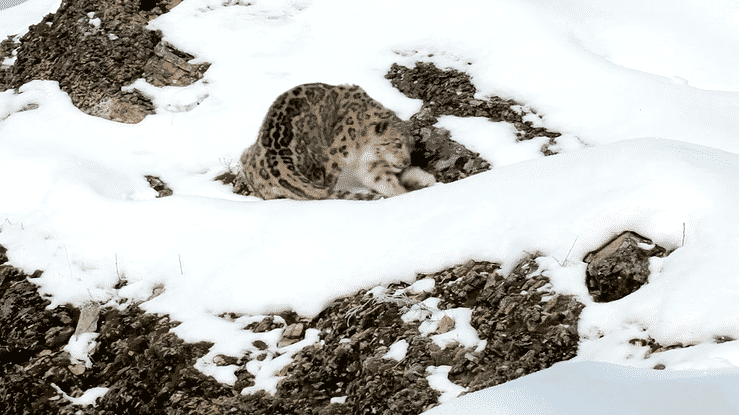
Apr 18, 2022 Snow Leopards – The High Mountain Ghosts of Asia
The mountain ranges north of India – the Himalayas, Hindu Kush, and the Karakoram- have attracted adventurers and children’s imaginations for centuries. Rudyard Kipling set his story of The Man who would be King in these ranges, and Huston used the Kipling story for his film of the same title starring Sean Connery and Michael Caine as two British soldiers who set out to find fame and fortune in these ranges. These areas encompass the legends of the Yeti (the Abominable Snow Man), the Tibetan Plateau (the original home of the Dalai Lama), and the ecosystems that sustain snow leopards.
The behavior and biology of this chunky, powerful large cat are poorly understood because its ecosystem is so challenging and inhospitable for both the snow leopards and researchers. However, the snow leopards have been able to adapt. Freezing temperatures and very mountainous, usually accompanied by low oxygen concentrations, are characteristics of this habitat. There are 14 mountains in the world more than 8,000 meters (26,250 feet) above sea level, and all of them are located in the Himalayan or Karakoram ranges. The amount of oxygen in the atmosphere drops as the altitude increases. For a person normally living at or near sea level, oxygen lack can become a health problem at around 8,000 feet above sea level (Bogota, Colombia, is 8.600 feet above sea level, and the Tibetan Plateau averages more than 13,000 feet above sea level. People can experience mild effects of altitude sickness (e.g., shortness of breath) at just 5,000 feet above sea level. At 8,000 feet above sea level, more severe altitude sickness symptoms, including headaches, loss of appetite, insomnia, and nose bleeds, are relatively common.
Studying snow leopards requires some amount of acclimation to high altitude and sufficient fitness to negotiate the paths up and down the mountains (roads are rare) to reach the snow leopard habitat. Snow leopards survive on wild sheep, ibex, marmots (a large rodent), hares, and pikas (another rabbit). Also, they will prey on livestock if their natural prey is scarce (usually because of human activities). However, livestock predation leads local villagers to poison snow leopards.
Snow leopard range is found in the mountain regions of 12 countries in Asia – China (60% of the habitat), India, Mongolia, Bhutan, Nepal, Pakistan, Russia, and five other countries in the region. Snow leopard density is relatively low (a maximum of 10 individuals every 100 square kilometers.
Snow leopards are fortunate in having some passionate human advocates. For example, Shafqat Hussain, a Pakistani anthropologist and recipient of a Rolex award for his efforts to protect snow leopards, is one such advocate even though he has never seen a snow leopard in the wild. He launched the Baltistan Wildlife Conservation & Development Organization to protect snow leopards from retaliatory killing and has been working in an area in the high mountains of Northern Pakistan that includes 26 villages and an estimated 30-50 snow leopards. As an anthropologist, Hussain emphasizes understanding human behavior as a first step in developing approaches that would protect snow leopards. Hussain explains that the local villagers are not inherently opposed to snow leopards; they want to be sure that when they suffer from snow leopard predation, the state or some other entity will compensate for the loss and damage to their livelihoods. Quite reasonably, local villagers argue that if the state believes it is essential to save the snow leopard, it must support humans who have to live with the animal. Successful prevention of retaliatory killings measures must provide prompt and fair compensation. However, government compensation schemes often involve drawn-out investigations and are thus unlikely to protect the dwindling population of snow leopards.
Successful compensation schemes have been developed to protect tigers, but often they involve a mix of government and private NGO funding. The private NGOs have more flexibility (fewer bureaucratic rules and processes) to make cash awards to aggrieved farmers. According to Hussain, the “good news” is that, unlike the situation with tigers, no snow leopard has been known to attack a human.
Very few people will ever see a snow leopard in the wild, so we have to rely on people willing to support snow leopard conservation even without any personal experience of these very elusive creatures. At least, unlike the Yeti, we do have films of these remarkable and beautiful animals.


